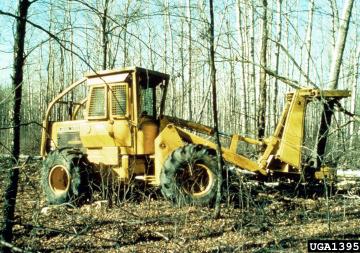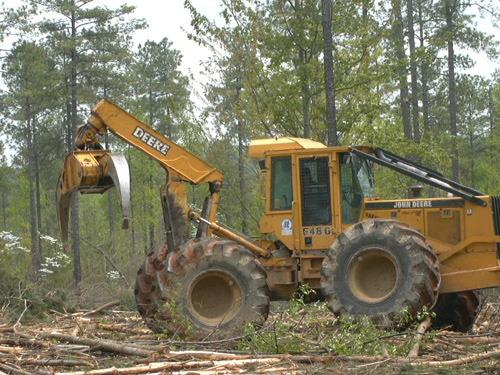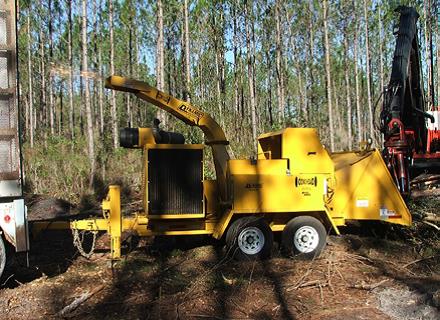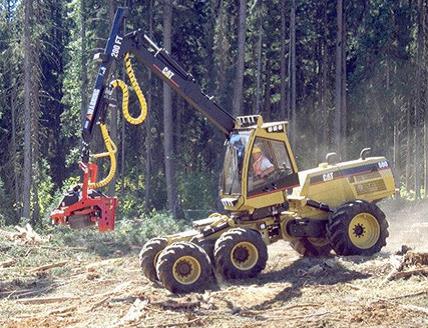Introduction
Woody biomass harvesting systems fell and recover woody biomass and transport it to a central location to be processed or directly loaded onto trucks for transport to a biomass-using facility. This can be done concurrently with a conventional timber harvest or as a separate harvest operation. While a number of conventional timber harvesting systems are physically capable of harvesting and recovering woody biomass, they must also be cost effective.
In general, large, highly mechanized harvesting equipment is more cost effective than special small-scale systems when working with smaller sized material (biomass products) due to high productivity. In other words, their ability to remove more tons of material per machine hour results in a lower cost per ton than smaller, less productive equipment. However, cost effectiveness remains a challenge because of high capital, operational, and transportation costs, the limited amount of material available per operation for biomass markets specifically, and the relatively low value of biomass at market. Tract size or total volume per site is also important. This fact sheet provides a general description of two of the more conventional biomass harvesting systems: one-pass and two-pass operations. It includes a list of advantages and disadvantages using conventional timber harvesting equipment versus small-scale or specialized harvesting systems for woody biomass recovery.
Harvesting Biomass with Conventional Systems
Conventional timber harvesting equipment, coupled with whole tree chippers or tub grinders, allows you to collect and pre-process woody biomass. However, the exact composition of the system used in harvesting and recovering woody biomass is generally determined by forest site, forestry traditions, infrastructure, landowner objectives, and desired level of integration into conventional logging systems. In general, the more integrated biomass collection is into a conventional system, the more cost effective it is.
One-pass Method. One-pass timber harvesting systems harvest roundwood and biomass simultaneously. This is the most cost effective extraction method when using conventional timber harvesting equipment such as feller/bunchers, harvesters, skidders, and forwarders to harvest and recover woody biomass (1). Most logging businesses favor this method because, other than adding a small to medium size chipper, they have to make few, if any, modifications to their current system. It provides value from traditional forest products. Moreover, landowners and managers are likely to prefer the one-pass system because the system provides energy or bio-based product value and reduces the cost of preparing the land for reforestation. Here are examples of one-pass systems that include woody biomass harvest and recovery.
• Whole-tree: Feller/bunchers are the most common felling equipment used for whole-tree harvesting. Two types can be used, depending on the characteristics of the site. Steeper slopes require a more expensive, tracked swing-to-tree machine, while more level terrain allows the use of less expensive rubber-tired, drive-to-tree feller/bunchers (Image 1). One or more rubber-tired skidders are used in this system (Image 2). Feller/bunchers fell all material, while skidders transport it to the log landing. At the landing, a chipper processes the biomass, while other merchantable products are sorted and loaded onto trucks for transport to the appropriate market. Limbs and tops from merchantable trees are also chipped. Amajor drawback of this system can be the grit contamination associated with the material being dragged across the ground (Image 3).
Image 1. Rubber Tire Feller/buncher source: USDAForest Service, www.forestryimages.net


Image 2. Rubber Tire Skiddersource: Rien Visser, Virginia Tech

Image 3. Chipper chipping biomass into a chip van. source: Michael Westbrook, University of Georgia
• Harvester-Forwarder: This system uses a harvester that processes (i.e. fells, delimbs, bucks and piles) both biomass and traditional products into separate piles (Image 4). A forwarder loads both types of material and carries them to a landing (Image 5). Traditional products are loaded with a conventional log loader while the biomass is chipped with a chipper. In this system, leaves, needles, parts of branches and tops remain on site. A forwarder eliminates most potential grit contamination.
Image 4. Harvester source: Rien Visser, Virginia Tech

Image 5. Forwarder source: Franz Holzleitner and Christian Kanzian, Boku

Two-pass Method. The two-pass method, which harvests and recovers roundwood and biomass in separate passes, is less popular and has not proven to be as cost effective as the one-pass method. In the two-pass system, unconsolidated biomass is either left in the woods or is piled near the landing for later processing and transport. One benefit of two-pass systems is that it offers the opportunity for smaller, specialized biomass harvesting contractors to operate if conventional timber harvesting contractors do not wish to process the biomass. Some examples of two-pass systems are:
• Pre-Harvest: In this system, traditionally unmerchantable trees of all sizes are felled for use as woody biomass. Biomass is felled by a feller/buncher before the conventional harvest. One or more skidders transport the woody biomass material to a landing, where it is chipped into a van and transported to the biomass using facility. Later, all traditional products are felled with feller/bunchers. Skidders then transport the products to a landing to sort and load the material for transport. This system offers some benefits because it reduces vegetation in the stand.
• Post-Harvest: In this system, all merchantable products are felled with feller/bunchers. One or more skidders transport the merchantable products to a landing to sort and load the material for transport. Later, feller/bunchers fell all woody biomass. Skidders transport the woody biomass to a landing to be chipped into a van and transported to the biomass using facility.
Table 1: Advantages and disadvantages of conventional biomass harvesting systems.
ADVANTAGES
• Can represent cost savings for subsequent silvicultural and site preparatory activities.
• For a landowner, harvesting woody biomass for energy might be a viable option for generating additional income from his or her property.
• Most loggers will likely favor conventional timber harvesting methods because they have to make few, if any, modifications to their current system.
• When the operator is off the ground and in an OSHA approved cab, highly mechanized timber harvesting equipment is generally safer.
DISADVANTAGES
• Conventional timber harvesting systems are larger, more capital intensive with higher operational and transportation costs. They are designed for large tracts of land or more valuable material.
• When fossil fuel prices are low, it is difficult to find conventional timber harvesting equipment operators willing to harvest biomass for energy related projects. Astrong market for woody biomass is essential in attracting service providers.
Summary and Conclusions
Timber harvesting system selection depends on a number of factors and conditions. Table 1 summarizes the advantages and disadvantages of using conventional timber harvesting equipment and methods to harvest and recover biomass. Even when the range of conditions is limited to relatively flat terrain with small trees in overstocked stands, there is no optimal system. Selecting the best timber-harvesting system within the available options often requires the services of an experienced operations planner. Please refer to “Small-scale Woody Biomass Harvesting Systems” for additional information on timber harvest systems.
Endnotes
1 Stokes, B.J.; Watson, W.F.; Savelle, I.W. 1984. Alternate Biomass Harvesting Systems Using Conventional Equipment. Paper presented at Sixth Annual Southern Forest Biomass Workshop, Athens, GA, June 5–7, 1984.
